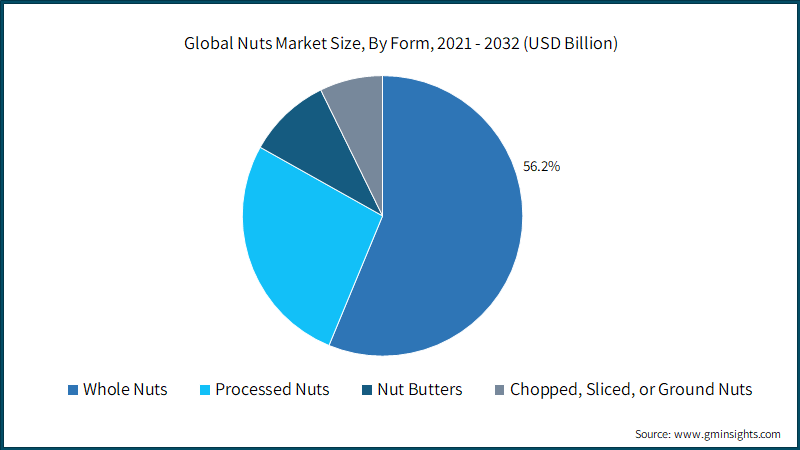Home > Food & Beverages > Processed Food > Convenience Foods > Nuts Market
Nuts Market Analysis
- Report ID: GMI6817
- Published Date: Sep 2023
- Report Format: PDF
Nuts Market Analysis
The nuts market from almonds segment held over USD 15.06 billion revenue in 2022. Almonds are excessive in nutrients, fiber, protein, and minerals. They're also low in calories and carbs. Almonds are related to several fitness benefits, inclusive of stroke, a lower threat of coronary heart disease, and type 2 diabetes. Almonds are a quick and easy snack to take on the run. They are also shelf-stable, which means they may be kept for long periods of time.

The whole nuts market accounted for 56.2% of revenue share in 2022. The most common kind of nuts are whole nuts. Because they have undergone less processing and contain more nutrients, whole nuts are the healthiest type of nut. Additionally adaptable, whole nuts may be consumed on their own, as an ingredient in meals and snacks, or in baking and cooking.
The nuts market from snack foods segment is anticipated to grow at 6.1% CAGR through 2032. In the upcoming years, it's expected that nuts will gain in popularity as a snack item. The general public's increasing awareness of nuts' health advantages, the need for quick, nutritious snacks, and the fact that nuts have been utilized to prepare a range of snack food meals are all contributing reasons. Due to their convenience and health advantages, nuts are a preferred snack item.

U.S. nuts market size dominated around USD 23.83 billion in 2022, driven by rising disposable incomes and increased awareness of the health advantages of nuts. In North America, almonds, walnuts, and peanuts are the most widely consumed nuts. North American customers are becoming more health-conscious and are looking for healthy snack options.
Growing interest in plant-based diets and the perception of nuts as a natural, healthful source of protein have further enhanced their popularity. As consumers prioritize healthier snacking options, demand for nuts in the North American market is likely to remain high, with a rising emphasis on product diversification, premium and organic offerings, and sustainable sourcing to match evolving consumer preferences.

